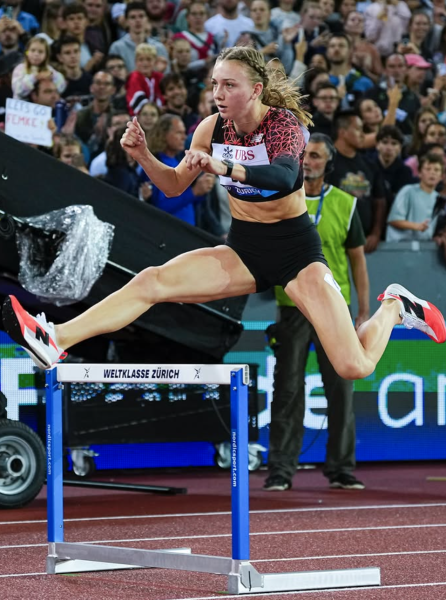In the world of professional track and field, no event looms larger — with the obvious exception of national, world and Olympic championships — than the Wanda Diamond League Final. The Diamond League is a meet series that has run every year — with the exception of 2020 — since its debut season in 2010. Athletes compete across 32 disciplines in 14 single-day meets spanning from April to late August or early September, hoping to earn a spot in the two-day Diamond League Final. The 2025 season’s finale took place Aug. 27 to 28 in Zurich, with some notable winners, record-setters, losers and missing athletes.
The Diamond League Final provides athletes a chance to cement themselves at the top of the world stage — before they actually have to earn that title a few weeks later. This year’s notable winners include the likes of U.S. sprinter Noah Lyles, who won his sixth Diamond League final, Swedish pole vaulter Armand “Mondo” Duplantis, U.S. discus thrower Valarie Allman and Dutch 400-meter hurdle specialist Femke Bol — all of whom won their fifth consecutive Diamond trophy. Ahead of the 2025 World Athletics Championships Sept. 13 to 21 in Tokyo, Japan, these athletes all stand a good chance at winning their respective events.

Let’s take a look at some more nuanced races, missing athletes, key losses and the rules that help make athletics, well, entertaining.
Athletes qualify for the Diamond League Final by earning points for placing in the top eight of their event at various meets throughout the season. Before the final, the total points athletes have earned throughout the season — 8 points for first, 7 points for second, 6 points for third and so on down to eighth — are calculated, and a ranking of athletes is developed for each event. The top six athletes in each field event, top eight athletes in races ranging from 100 meters to 800 meters, including hurdles, and the top 10 athletes in any event 1500 meters and longer are invited to compete in the Diamond League Final. Occasionally, athletes who did not rank high enough in their event to qualify for the final but who competed in at least one Diamond League meet that season can be given a global or national wild card permitting them to compete in the final — that is, provided they are either a world record holder, a reigning world, Olympic or Diamond League champion, ranked incredibly high in their event or overall by World Athletics or a Swiss national.
That’s how Noah Lyles ran the 200-meter in Zurich. Lyles qualified for the Diamond League Final in the 100-meter ranked third, having placed second in the event three times throughout the 2025 season. Lyles was ranked 11th in the 200, having run the event and won it once this season. (Lyles also won the USA Championship in the 200 Aug. 3). Lyles took the global wild card for the 200 and scratched the 100 — using the opportunity as a tune up for his 200 in a few weeks at the World Championships. Without the global wild card, we would have had a different winner for the 200, and a potentially different winner for the 100.
Another wild card hopeful, Norwegian distance phenom Jakob Ingebrigtsen, succumbed to a different issue. Having missed most of the season with an Achilles injury, reigning three-time 1500-meter champion Ingebrigtsen was looking for a chance to tune up ahead of the upcoming World Championships. The Diamond League denied Ingebrigtsen a wild card, given he had not competed in a qualifying meet throughout the season. U.S. hurdle and sprint champion Sydney McLaughlin-Levrone suffered the same fate last season.
Other notable athletes turned down the Diamond League finals competition and chance at a $30,000 prize. 1500 runners Nikki Hiltz from the United States and Faith Kipyegon from Kenya, ranked third and 10th respectively in the event, skipped the Diamond League final in the name of preparing for the upcoming World Championships. Kipyegon was the reigning four-year 1500 champion and has had a phenomenal season in which she set a new world record in the 1500 and ran a time faster than her mile world record in her Breaking4 campaign in July. Hiltz has also had a remarkable season thus far — in Brussels the week prior, they became the first American to win the Diamond League women’s 1500 since 2018 and were later crowned USA Track and Field athlete of the week for their performance.
On the men’s side of the 1500, Yared Nuguse of the United States hoped to secure the win and a spot at the upcoming World Athletics Championships. Nuguse was looking to obtain a wild card to Tokyo as the 2025 Diamond League winner after failing to garner a spot on the Team USA roster at the U.S. track and field championships earlier in the month. Despite maintaining positioning until the final 100m, the world No. 1 ranked Nuguse failed again, finishing seventh of 10 athletes, and he will not be making the voyage to Tokyo to compete in a few weeks’ time.
In contrast to the unfortunate end to Nuguse’s outdoor season, this year’s Diamond League season was a success — it always is. Diamond League final tickets sold out in less than two hours. Unlike Michael Johnson’s Grand Slam Track league that died out before its final meet in June, the Diamond League is a constant in the major track circuit. It’s the lead up to the pinnacle of competition each season and an opportunity to qualify for the World Championship. Like past seasons, this year’s meet brought excitement, decisive wins and heartbreak. What more could you ask for?